Decades ago, when I was into cruising long distances under oar, sail, and paddle, I accepted roughing it as a necessary part of the wilderness experience. In recent years I’ve shifted my focus from making miles to enjoying shorter adventures in comfort. And rather than carrying food merely as fuel to provide the calories I need with as little time and effort as possible spent in cooking, I now indulge in meals I make onboard that are often better than those I make at home. A good food-preparation knife and a cutting board have become part of my standard boating kit.
The new folding knives from nCamp have elevated my standards for what makes a good galley knife. The knives are available with Santoku and Chef blades in two grades—Premium and Elite. Each of the four models has wooden scales forming the grips on either side of the handle, three triangular holes that make it possible to open the knife with a thumb, and liner locks to hold the blade open. The handles are offset from the cutting edges to provide clearance for the knuckles above the cutting surface. I’ve been using the Premium Chef and the Elite Santoku and, right out of the box, both easily pass the usual sharpness test—slicing cleanly into the edge of a sheet of paper.
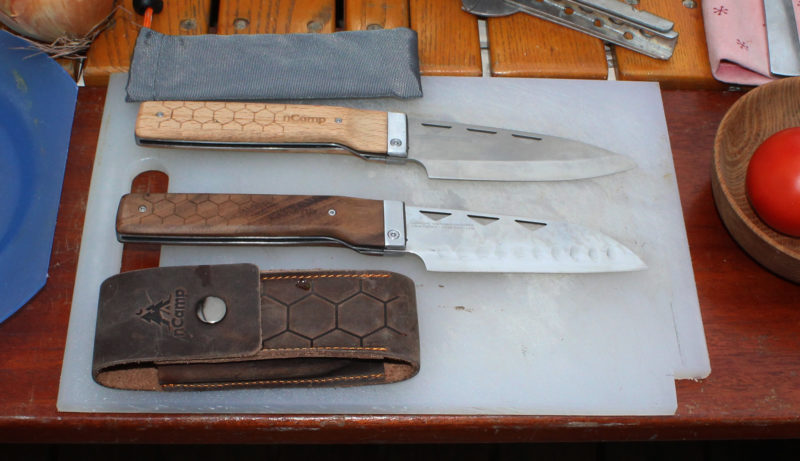 Photographs by the author
Photographs by the authorThe Premium knives, like the Chef at top, come with a nylon bag. The Elite models, like the Santoku at bottom, come with a leather case.
The Premium Chef is nCamp’s more economical version of the Chef. It has beechwood scales on the handle and a blade made of a high-carbon stainless steel (9Cr18MoV) with chromium for high corrosion resistance and molybdenum for strength. It is 10 3⁄4″ long when open with a 5″-long blade. Closed, it is 5 3⁄4″ long. It weighs 5.8 oz. The blade has a 1⁄2″-wide hollow grind along the cutting edge and a 1⁄32″ microbevel. The Premium knives come with a nylon bag equipped with a drawcord and spring-loaded lock.
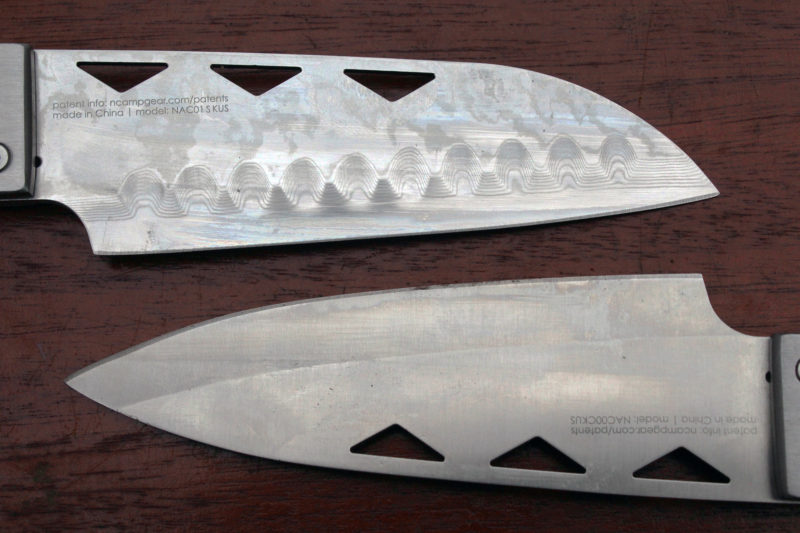
The Damascus steel used for the Elite knives (top) gets etched with acid to bring out the patterns created by the layers of different steel. The scalloped part of the blade keeps food from sticking. The Premier blades (bottom) are hollow ground. This Premier is the Chef model, which has a blade with a more pronounced curve than the Santoku type above it.
nCamp’s top-of-the-line Elite version of the Santoku has a walnut handle and the same dimensions as the Chef but is 0.1 oz lighter. Its blade has an inner laminate of high-carbon, high-chromium stainless steel (10Cr15MoV) for corrosion resistance and strength, sandwiched between Damascus steel layers for toughness. The multiple laminates within the Damascus are visible as parallel stripes of different shades of gray; they don’t have the intricate patterns associated with fancier decorative versions of Damascus steel. On each side of the blade a series of 10 scallops set 1⁄4″ away from the cutting edge reduces drag while slicing. The blade has a hollow grind that’s 7⁄16″ wide and about half as deep as the Chef’s with a similar microbevel. The Elite knife comes with a sturdy leather case with a belt loop.
Both the Chef and the Santoku can be opened and closed with one hand by pressing the thumb into one of the triangular holes. Using the hole closest to the pivot can open the blade completely in one motion, though it takes a bit of practice and effort. It takes less effort to pinch the hole farthest from the pivot with the thumb and middle finger to swing the blade partially out of the handle and then fully extend it by holding the blade’s tip on a cutting board. The liner locks are easy to operate when closing the knives. The pivot of each knife operates smoothly without being too stiff and when the blade is fully extended and locked it has a solid, immobile connection with the handle.
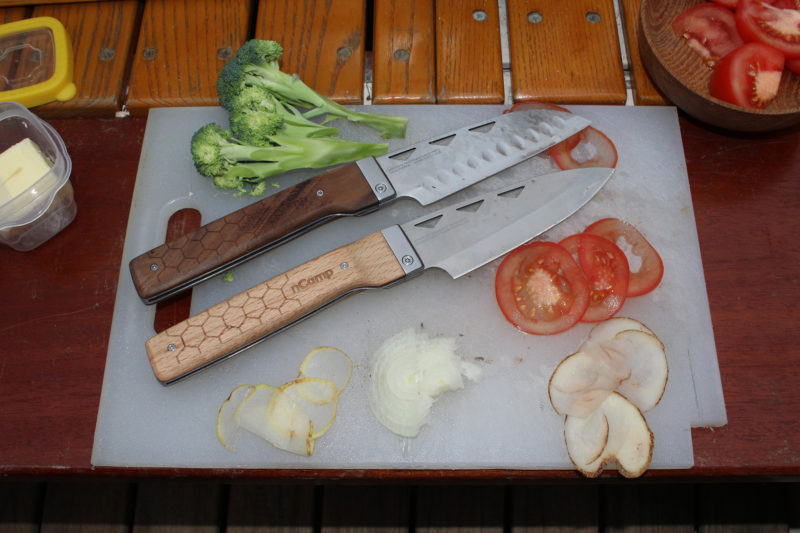
The steel at the cutting edges of both knives can take a very sharp edge and easily sliced vegetables thin enough to see through.
The handles provide a comfortable, secure grip even for my extra-large hands, and both blades have made quick work of cutting everything from chicken breasts, cucumbers, and russet potatoes to tomatoes and broccoli. The nCamps outperform the best chef knives I keep in my kitchen and take an edge that’s the equal of my 50-year-old high-carbon-steel Chinese cleaver, the sharpest food-prep implement I’ve ever owned.
I was pleasantly surprised by the Elite Santoku while I was cutting broccoli—the blade seemed to glide through the stalks with little effort on my part. When I tried the same cuts with the Premium Chef and two of my kitchen paring knives, the difference was easy to feel. Compared to the Santoko, the Chef took a little more effort and the paring knives seemed to take twice as much. The scallops on the sides of the Elite blade, as intended, significantly reduced the drag of the blade while cutting. I found the same effect with everything else I cut with it except butter.
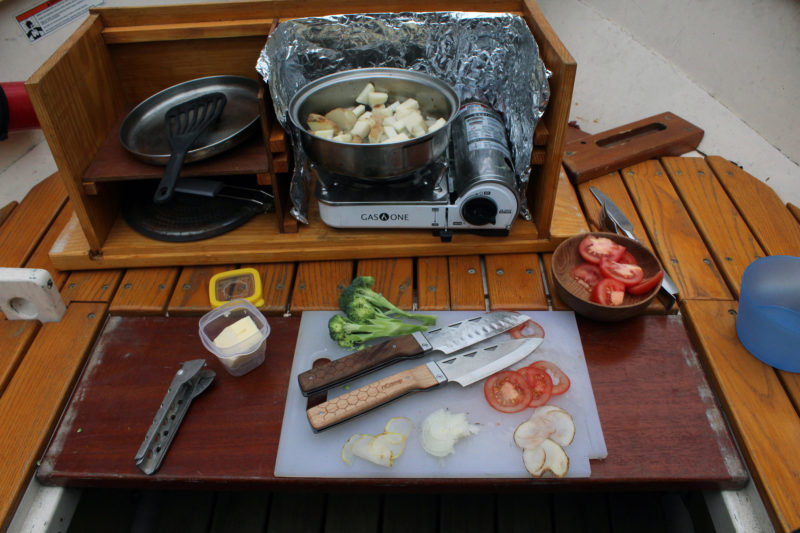
The nCamp knives, especially the Elite Santoku, start an enjoyable meal by making its preparation quick and pleasurable.
With folding blades that protect the edges—and me—the Chef and the Santoku take up little room in my galley box, but they won’t take up permanent residence there. It’s such a pleasure to use them that they’ll spend their time between cruises in my kitchen.![]()
Christopher Cunningham is the editor of Small Boats Magazine. He has been taking notes while cruising since 1980.
The Chef and Santoku knives are available from nCamp. The Premium versions cost $75 and the Elites cost $150. Small Boats readers can use discount Code BOAT35, and get 35% off the list prices. Offer ends May 31, 2023.
Is there a product that might be useful for boatbuilding, cruising, or shore-side camping that you’d like us to review? Please email your suggestions.



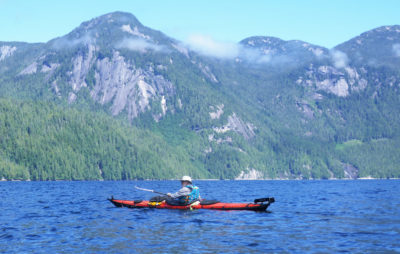
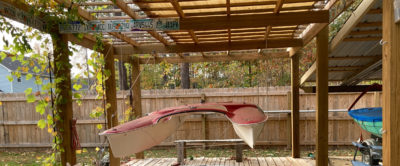
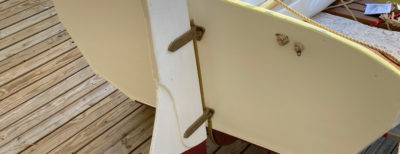
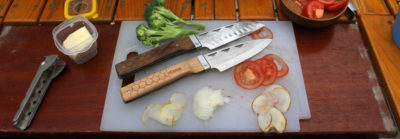

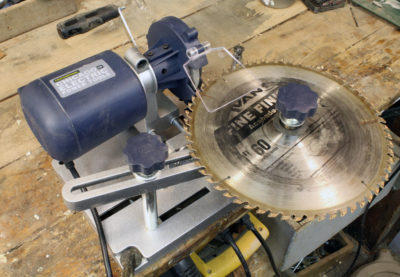
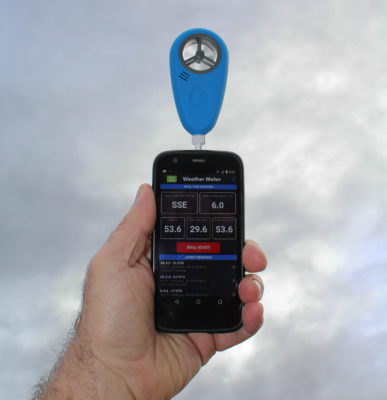
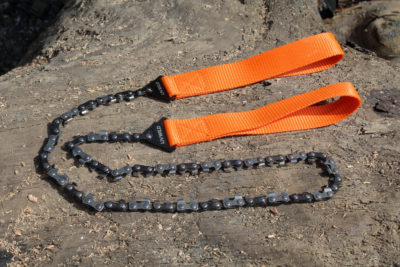
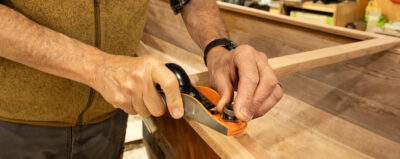
Steve at Firebox Stoves.com has been testing a folding chef’s knife that he helped develop , and just recently brought it to market. It is getting good reviews from his customers. He also markets round cutting boards that come in different sizes to match his varuios sized cook kits that he has developed. I bought the 9 inch one because it fits inside of my 10 inch frisbee. The frisbee keeps the food being prepped from falling off the cutti ng board. After the food has been prepared, I use the frisbee as a plate to eat out of. It is not hot, keeps the food on the plate, and use it to fan a open flame, etc. I don’t have a dog, so I don’t have to share it.
I just order the Santoku knife. Been looking for a folding chef knife for camping. Also got the espresso maker. Happy camper. Thanks for publishing this kind of unique stuff.